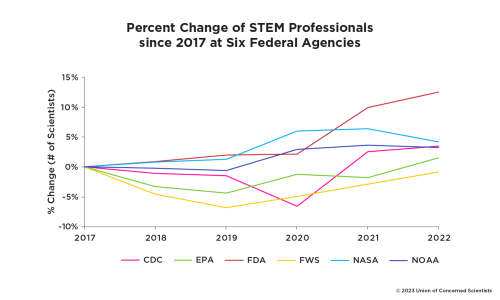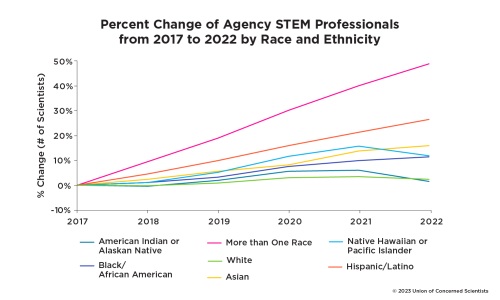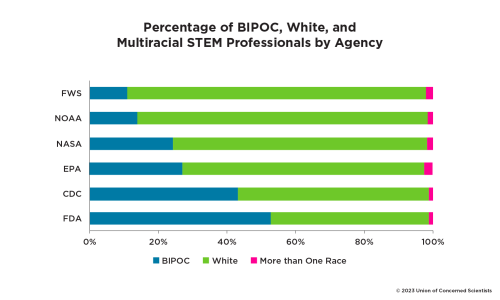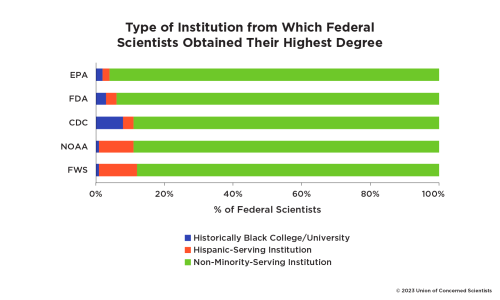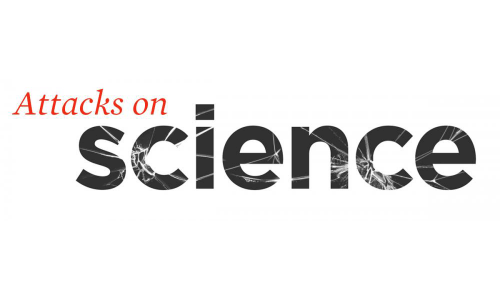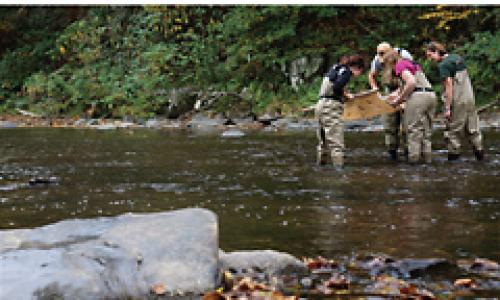Thousands of scientists and experts left federal jobs between 2016 and 2020, in many cases driven out by a hostile political climate, leaving a lack of capacity that undermined federal agencies’ ability to successfully accomplish their missions on behalf of the public. This report finds that, while most federal agencies have slowly managed to build back capacity over the past five years, progress is inconsistent across agencies and significantly more work is needed to attract and retain a diverse workforce at federal agencies.
Based on input from a roundtable of experts who assessed progress at science-based federal agencies, the report finds today’s scientific and technical workforce at the federal level still doesn’t reflect the diversity of the country, with scientists from historically excluded communities still under-represented in these jobs. It offers concrete steps federal agencies can take to improve recruitment, retention, and diversity to ensure a scientific workforce that reflects and addresses the needs of a diversifying country.
Strengthening and Diversifying the Federal STEM Workforce
From 2016 to 2020, thousands of scientific experts left, retired, or were forced out of the federal agency workforce—at least in part because of challenges faced under a science-unfriendly administration—and were not replaced by new hires (Carter, MacKinney, and Goldman 2021). The federal government's ability to fully staff its scientific workforce affects the nation's health and safety, because government scientists inform important decisions that keep the air and water clean, ensure access to vaccines to stave off serious illness, and make communities more resilient to natural disasters like floods and wildfires.
A loss of federal scientific capacity not only impacts government decisions that affect public health and safety, but also affects the quality of scientific work. When organizations lose employees, the workload does not decrease. Without enough staff, an organization's existing employees are often burdened with a heavier workload that can result in burnout, higher levels of stress, lower performance, and lower quality of work (Maslach and Leiter 2016). Maintaining the integrity of scientific research also is challenging under conditions of high workloads, limited capacity and tools, and fast turnaround.
Current State of the Federal Government's Scientific Capacity
Recently, there has been good news for the federal government's scientific capacity since losses began during the Trump administration. A new Union of Concerned Scientists (UCS) analysis using data from the US Office of Personnel Management (OPM 2022a) found that the number of federal scientists increased across six major science-based federal agencies from 2017 to 2022 (Figure 1). However, some agencies, such as the Environmental Protection Agency (EPA) and the Fish and Wildlife Service (FWS), needed five years to rebuild its scientific capacity back to 2017 staffing levels. In other words, it took five years for these federal agencies to restaff after losing scientific experts during the Trump administration.
While it is a positive development that staffing levels for science, technology, engineering, and mathematics (STEM) personnel have returned to 2017 levels, evidence suggests that there is currently not enough scientific capacity for federal agencies to meet their missions effectively. According to a survey of federal scientists released in 2023 by UCS, the scientific workforce struggles to meet work demands (Desikan and Carter 2023). Fifty-nine percent of surveyed scientists (982 respondents) reported noticing staff departures and retirements, or hiring freezes, in the past two years. Of these respondents, 88 percent (868 respondents) agreed that a lack of capacity made it difficult to fulfill their agencies' science-based missions.
Figure 1:
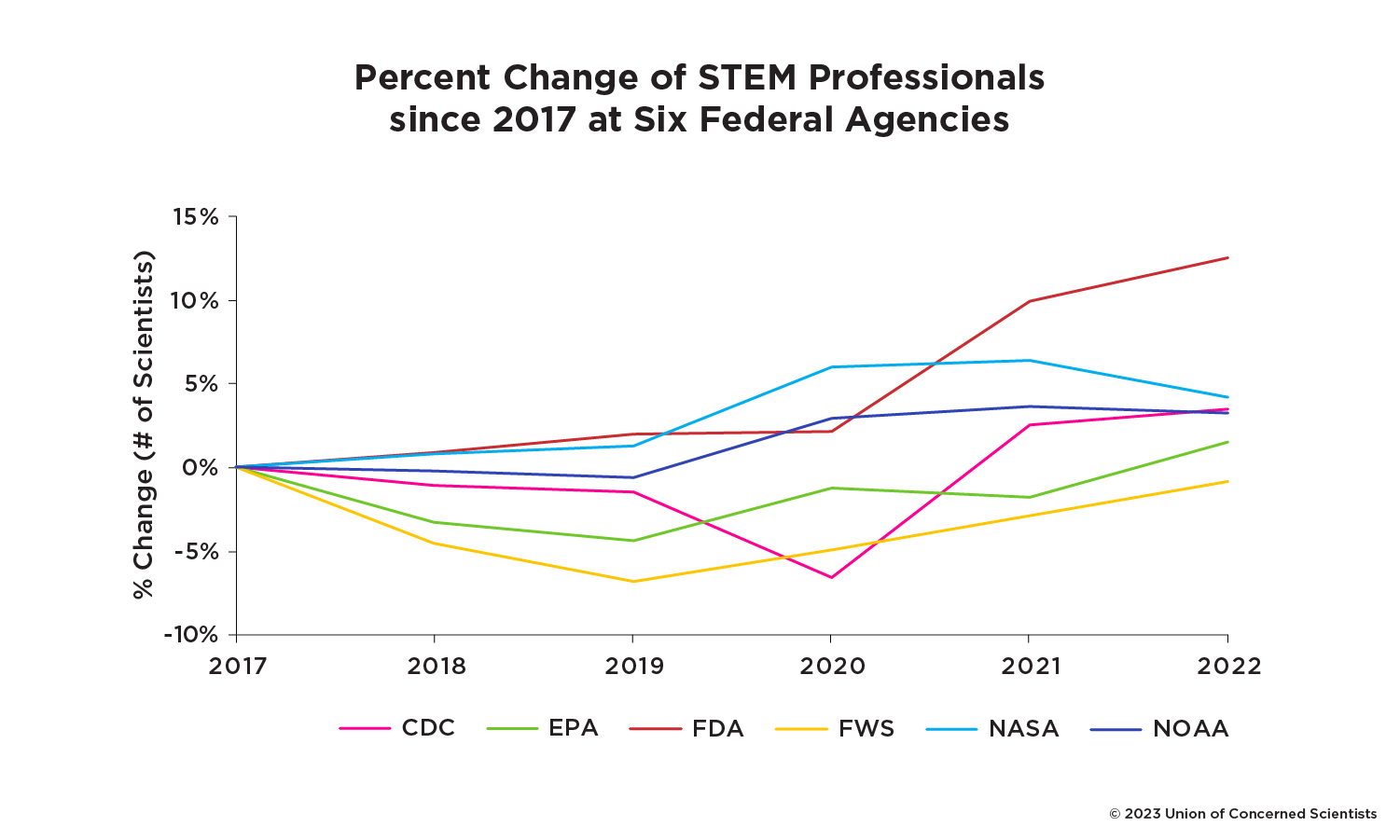
Caption: From December 2020 to December 2021, both Centers for Disease Control and Prevention and Food and Drug Administration experienced sharp increases in the hiring of scientific experts (9.8 and 7.6 percent, respectively). However, both EPA and FWS first experienced a loss of scientific experts, with a low point in 2019, and then a recovery period, requiring until 2022 to get back to staffing levels seen in 2017.
Note: Years represent December 2017 to December 2022. Please see the appendix for a more detailed description of the methodology.
At the majority of agencies surveyed, respondents chose limited staff capacity as the greatest barrier to science-based decision-making, selecting it over 15 other possible answers. At the Food and Drug Administration (FDA), an exception, limited staff capacity ranked as the second greatest barrier. According to OPM data, the FDA's number of scientists grew far more than any other agency observed from 2017 to 2022 (Figure 1).
Sixty-two percent of federal scientists surveyed said that they experienced burnout in the past two years, and 70 percent of those who reported burnout said it was because of staff capacity (Desikan and Carter 2023). These results appear to mirror findings showing widespread burnout among academic scientists. A 2021 study by Nature found that 42 percent of 3,200 scientists who responded to the journal's survey had sought help or wanted to seek help for job-related anxiety or depression (Woolston 2021).
Workplace morale for federal scientists may be tied to an agency's culture of scientific integrity, that is, whether an agency has safeguards in place to protect scientists and their work from inappropriate political interference. A 2022 report by the White House's National Science and Technology Council stated that "an environment characterized by weak scientific integrity can further undermine federal science by making it more difficult for federal agencies to attract, recruit, and retain a diverse workforce of highly qualified scientists and engineers" (SI-FTAC 2022).
Goldman et al. (2020) surveyed over 4,200 federal scientists in 2018 and found that federal scientists' perceptions of scientific integrity appeared to be influenced by the degree to which that they felt valued and effective in their workplaces and by their perception of the trustworthiness and competence of agency leadership. A follow-up study in 2022 of over 1,800 federal scientists similarly found a positive link across job effectiveness, perceptions of scientific integrity, and workplace morale (Desikan and Carter 2023).
Taken together, this evidence indicates that strengthening scientific integrity policies at federal agencies may have a knock-on effect of making a federal agency a more attractive environment for recruiting federal scientists and increasing retention.
Diversity, Equity, Inclusion, and Accessibility in the Federal STEM Workforce
On June 25, 2021, President Joseph Biden signed the Executive Order on Diversity, Equity, Inclusion, and Accessibility in the Federal Workforce (Office of the US Presidency 2021a). It states, "The Federal Government should have a workforce that reflects the diversity of the American people. A growing body of evidence demonstrates that diverse, equitable, inclusive, and accessible workplaces yield higher-performing organizations."
Among the many good, actionable steps this executive order outlines is a government-wide approach to diversity, equity, inclusion, and accessibility (DEIA). It charges the executive branch with doing better in partnering with academic institutions and organizations representing early career scientists from historically excluded populations.
The executive order put several initiatives into action, including those assessing the current state of DEIA within the workforce, developing strategic plans to eliminate barriers faced by historically excluded employees, expanding DEIA training throughout the federal workforce, addressing workplace harassment, advancing pay equity, and building a more diverse pipeline through recruitment partnerships with minority-serving institutions (MSIs; Office of the US Presidency 2021b).
In the United States, the STEM workforce is gradually diversifying, with increasing representation of women and individuals identifying as Black, Indigenous, and people of color (BIPOC; NCSES and NSF 2023). However, evidence suggests that the scientific workforces at federal agencies, to varying degrees, continue to lack representation of staff who identify as BIPOC; lesbian, gay, bisexual, transgender, queer, questioning, intersex, asexual (LGBTQQIA) LGBTQQIA; people with disabilities; women; and other historically marginalized groups. These inequities have existed for a long time. For instance, the Department of the Interior (DOI) has known that it had a lack of diversity in its staff since at least the 1930s (Jacobs and Hotakainen 2020).
A 2021 report from the US House of Representatives Science, Space, and Technology Committee concluded that racial and ethnic employment gaps exist within the federal agency STEM workforce. The report also found that gender employment gaps are more pronounced within the federal STEM workforce than in the larger federal workforce, especially within the engineering fields (HCSST 2021).
Figure 2:
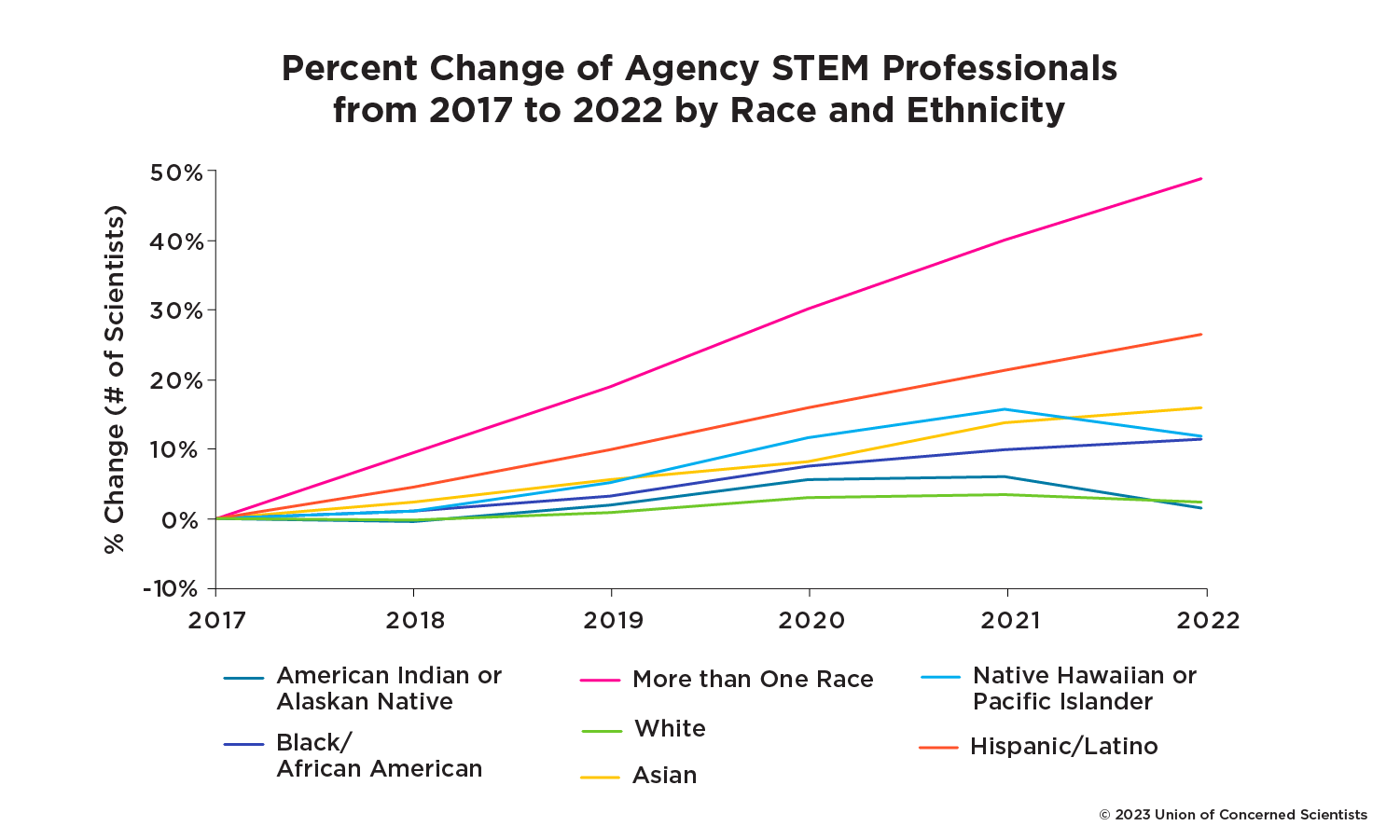
Caption: BIPOC-identifying scientists increased as a percentage of STEM professionals, with the largest gains observed for individuals who identified as more than one race, Hispanic/Latino, or Asian (49.0, 26.5, and 16.0 percent, respectively). However, from December 2021 to December 2022, agencies experienced a sharp decrease in the percentage of STEM professionals from two groups: American Indian or Alaskan Native and Native Hawaiian or Pacific Islander (4.2 and 3.2 percent, respectively).
Note: Data are from all federal agencies, from December 2017 to December 2022. The "unspecified" group had inconsistent reporting across agencies; these data are not shown in the graph (the category made up 0.5 percent or less of STEM professionals every year). Please see the appendix for a more detailed description of the methodology.
Inequities in the federal STEM workforce can differ across regions. Arismendi and Penaluna (2016) found that the Midwest had the largest representation of BIPOC scientists in the fisheries department of federal agencies, while the West had the lowest representation. However, the South and Midwest had the lowest representation of female scientists in the fisheries department, while the Northeast had shown the most progress in the inclusion of female scientists. The study defined the scientists who work at the fisheries department of federal agencies as white-collar US federal employees between General Schedule-11 (GS-11) to GS-15 employed as a Fish Biologist at any agency or who worked at FWS. It is not clear from current research why such regional discrepancies exist, but bias, cultural and socioeconomic factors, and discrimination have played a role when this phenomenon has been observed across other work sectors (OSTP and OPM 2016; IWGIS 2021; GAO 2020a).
Data on LGBTQQIA individuals and people with disabilities in the federal scientific workforce are lacking, but research from academia indicates that people who identify as LGBTQQIA or who have disabilities have long been marginalized in STEM professions (Freeman 2020; Bernard 2021).
The civilian labor force has become more racially and ethnically diverse and shown an increase in the number of women during the past three decades, though staff diversity varies across occupations and workplace sectors (Lam 2015). Recent data from OPM show that the federal STEM workforce has diversified since 2017 (Figure 2). However, these numbers do not reflect where staff from historically excluded populations serve in the federal government, an important consideration given that BIPOC individuals are typically hired into lower-paying roles, compared to their White counterparts (Williams 2019). This is also the case for federal STEM jobs (Edwards et al. 2021).
Furthermore, these numbers do not reveal whether some federal agencies are more diverse than others---an issue elucidated by UCS's 2023 federal scientists survey. Seventy-four percent of FDA scientists surveyed perceived the STEM workforce at their agencies as reflecting the nation's diversity. However, scientists surveyed at FWS and the National Oceanic and Atmospheric Administration (NOAA) perceived that their agencies lacked a diverse STEM workforce, and most scientists surveyed did not perceive their senior leadership as diverse (Desikan and Carter 2023).
The UCS analysis of the latest demographic data available from OPM, from December 2022, also reflects these findings and shows that racial and ethnic inequities continue to persist at agencies (Figure 3). In 2022, two agencies, FWS and NOAA, had an overrepresentation of White-identifying individuals within the STEM workforce (85 percent for both agencies), compared to the representation of BIPOC individuals (11 percent for FWS and 14 percent for NOAA). These findings may reflect a larger problem in geoscience and earth science, which are among the least diverse across all scientific fields; for instance, nearly 90 percent of people receiving doctoral degrees in geoscience are White (Goldberg 2019).
In comparison, the Centers for Disease Control and Prevention (CDC) and FDA both had a strong representation of BIPOC-identifying individuals within the federal STEM workforce (43 and 52 percent, respectively; Figure 3). For context, a Pew Research Center study found that 33 percent of scientists in health-related STEM occupations identify as BIPOC or mixed race (Fry, Kennedy, and Funk 2021). Taken together, this research appears to indicate that the CDC and FDA STEM workforces may be more diverse than their academic counterparts in health-related STEM professions.
The US Census 2020 showed that White individuals who did not identify in any other racial and ethnic category made up 64 percent of the adult population (18 years and older; Jones et al. 2021). The last time that the White population not of Latine origin represented more than 80 percent of the US population was during the 1970 census (Gibson and Jung 2002).
Figure 3:
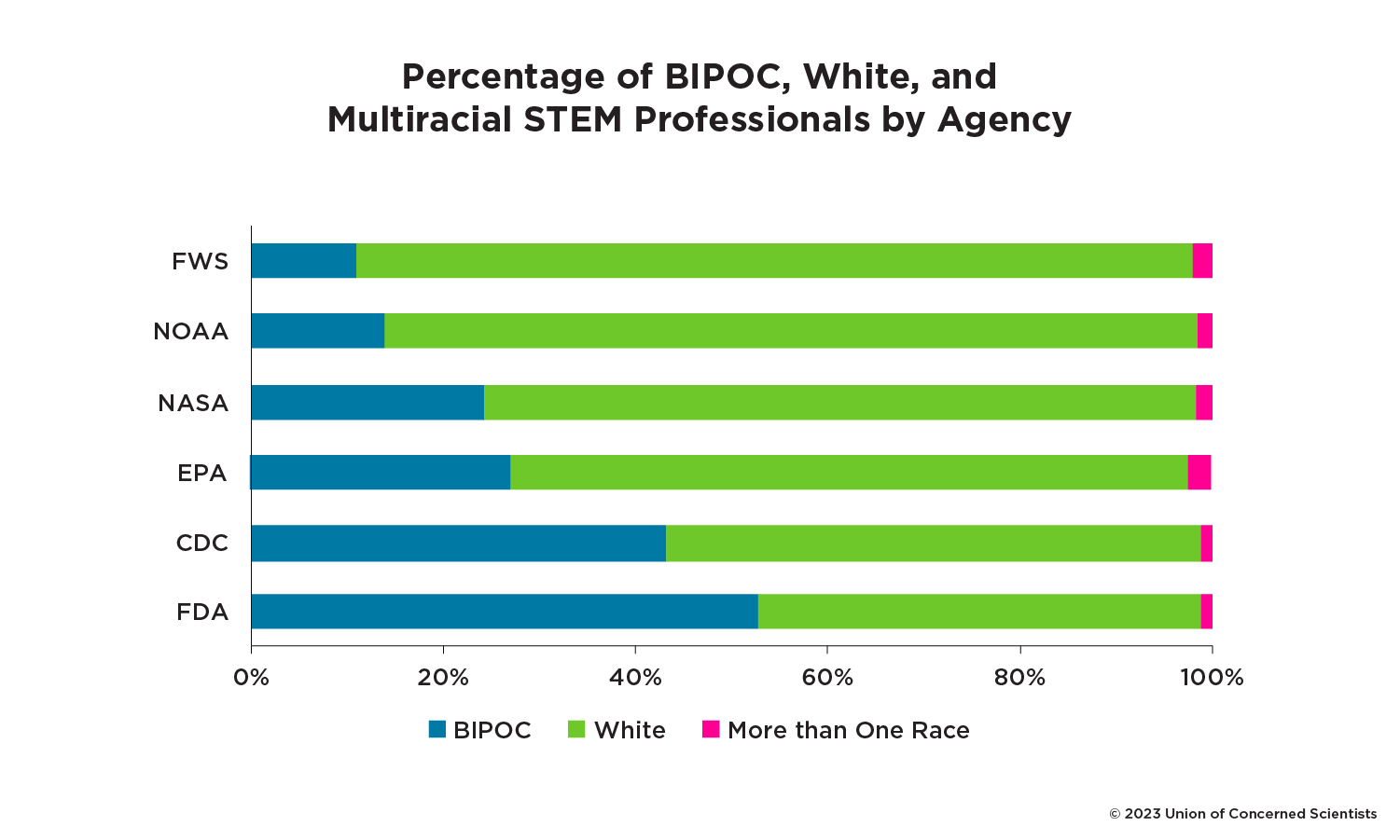
Caption: Percentage of STEM professionals who identify as BIPOC, White, or more than one race at six federal agencies. FWS and NOAA had an overrepresentation of White-identifying individuals within their STEM workforces (85.5 and 84.7 percent, respectively) compared to BIPOC individuals (10.8 and 13.9 percent, respectively). CDC and FDA both had strong representation of BIPOC-identifying individuals in their STEM workforces (43.2 and 52.7 percent, respectively).
Note: Data are from December 2022. Only EPA, FWS, and NOAA included the "unspecified" racial and ethnic group; data are not shown in the graph (the "unspecified" category made up 1.7 percent or less of STEM professionals at each agency). The BIPOC category consists of the following racial and ethnic groups: American Indian or Alaskan Native, Asian, Black/African American, Hispanic/Latino, and Native Hawaiian or Pacific Islander. Please see the appendix for a more detailed description of the methodology.
The government's workforce is not unique; diversity in the US STEM workforce has experienced very little change during the past decade. According to a National Science Foundation (NSF) report on diversity in the STEM workforce, only incremental changes in diversity have occurred from 2011 to 2021 (NCSES and NSF 2023). During this time, individuals identifying as Black have seen their representation increase in the STEM workforce, from 7 percent in 2011 to 9 percent in 2021, although the Black population represents 13.6 percent of the US population. The representation of people identifying as American Indian or Alaska Native—racial categories that together make up 1.3 percent of the US population—increased by only 0.2 percent over this same period, from 0.4 percent in 2011 to 0.6 percent in 2021 (NCSES and NSF 2023; US Census Bureau, n.d.).
However, efforts to diversify STEM fields have lagged behind those of other previously White male--dominated professions (Cech and Waidzunas 2021). According to a 2021 analysis by the Pew Research Center, Black and Latine adults are less likely to earn degrees in STEM than in other fields, and they continue to make up a lower share of STEM graduates relative to their share of the adult population. The same analysis showed that while women make up half of those employed in STEM jobs, representation varied widely across different STEM professions, with women representing three-quarters of health-related jobs and only one-quarter or less of computing and engineering jobs (Fry, Kennedy, and Funk 2021).
Diversity in STEM professions also depends on whether the pipeline into the profession—that is, college or graduate students majoring in STEM—consists of a diverse student pool. Also affecting this issue, a 2023 US Supreme Court case that ended affirmative action for college and university admissions will likely decrease the diversity of student bodies, including students obtaining STEM degrees. Affirmative action ended at the state level in California in 1996, and ensuing state university representation levels allow a glimpse of the Supreme Court decision's impact. In 1996, California passed Proposition 209, which ended affirmative action in the state's public universities and negatively affected racial and ethnic diversity at public universities. The state's most selective universities—University of California, Los Angeles and University of California, Berkeley—saw nearly 40 percent declines in the enrollment of Black and Latine students. Evidence suggests that Proposition 209 decreased statewide workforce inclusion of people of color and women (NPR 2023; Sumner et al. 2008).
There is clearly room to increase the number of scientific experts employed by the federal government as well as the diversity of that workforce. Given the critical role that these experts play, by informing government decisions that impact the health and safety of all residents' lives, everyone benefits from a stronger federal STEM workforce. Research also shows that more diverse groups consider a broader set of information and make decisions that are more effective (Sommers 2006; Ellemers and Rink 2016).
The call for a more a diverse federal workforce continues to grow; for instance, in 2023 the EPA's largest union---the American Federation of Government Employees (AFGE) Council 238---pushed the agency to include a DEIA article in its union contract, a measure supported by 44 House representatives (Bogardus 2023). A stronger and more diverse federal STEM workforce is not only a moral imperative, but a transition with a lasting positive impact for public and environmental health.
A Roundtable Discussion to Address These Issues
This report is the result of a UCS roundtable discussion held February 23--24, 2023, with the goal of bringing experts together to discuss the best practices for strengthening and diversifying the federal STEM workforce using equitable and evidence-based approaches.
The roundtable's panel of seven experts consisted of current and former federal scientists, individuals from academic institutions, and nonprofit experts. These individuals were brought together because of the diversity of their experiences on this issue, whether that experience involved their understanding of how university mentors coach students on their careers or their hiring of individuals into the federal government as leaders in a federal agency. Over two days, this roundtable of experts had open and honest conversations about the current challenges to strengthening and diversifying the federal STEM workforce, including issues such as compensation, mentoring, recruitment, retention, and salary. This report includes their recommendations for addressing these challenges.
While the report discusses various practices that can help recruit and retain diverse STEM professionals in the federal workforce, the authors have designated two areas as out of the scope of this report: human resource management processes and procedural challenges associated with navigating USAJOBS.gov. The panel felt that these areas merit an investigation and a concerted effort for revision and reform. For example, virtually all the experts noted the USAJOBS.gov tool as a major barrier to attracting new talent, based on their extensive contacts with early and midcareer scientists.
Chapters 2, 3, 4, and 5 summarize the current challenges and barriers to strengthening and diversifying the federal STEM workforce. These chapters reflect a comprehensive review of studies, reports, and federal programs on these issues. Chapter 6 provides issue-specific recommendations to address the challenges. Many of the experts who participated in UCS's roundtable discussion authored the subsections of chapter 6.
Citation
Desikan, Anita, Jacob Carter, F. Abron Franklin, Raechel McKinley, Jennifer Orme-Zavaleta, Andrew A. Rosenberg. 2023. Diversifying the Federal STEM Workforce. Cambridge, MA: Union of Concerned Scientists. https://doi.org/10.47923/2023.15242
